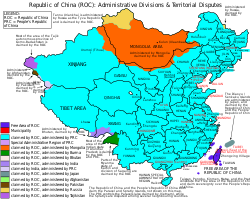Tannu Uriankhai
| Tannu Uriankhai | ||||||||
| Таңды Урянхай | ||||||||
| Unorganized Autonomous Region of Qing dynasty | ||||||||
|
||||||||
|
Tannu Uriankhai (shown in yellow) was located north of Mongolia.
|
||||||||
| Capital | Not specified | |||||||
| Languages | Tuvan, Russian | |||||||
| Religion | Tibetan Buddhism, Shamanism | |||||||
| Government | Feudal | |||||||
| Historical era | 19th century-1921 | |||||||
| • | Established | 19th century | ||||||
| • | Disestablished | August 14, 1921 | ||||||
|
||||||||
| Today part of |
|
|||||||
Tannu Uriankhai (Tuvan: Таңды Урянхай, Tangdy Uryankhai, [tɑŋˈdə urjɑnˈxɑj]; Mongolian: Тагна Урианхай, Tagna Urianhai; Russian: Урянхайский край, Urjanchajskij kraj, [urjɐnˈxajskiː ˈkraj]; simplified Chinese: 唐努乌梁海; traditional Chinese: 唐努烏梁海; pinyin: Tángnǔ Wūliánghǎi) is a historic region of the Mongol Empire and, later, the Qing dynasty. The realms of Tannu Uriankhai largely correspond to the Tuva Republic of the Russian Federation, neighboring areas in Russia, and a part of the modern state of Mongolia.
Tannu designates the Tannu-ola Mountains in the region. Uriankhai was the Mongolian name for the Tuvans (and accordingly their realm), which meant "the people living in the woods" (Chinese: 林中百姓; pinyin: Lín zhōng bǎixìng).
...
Wikipedia


